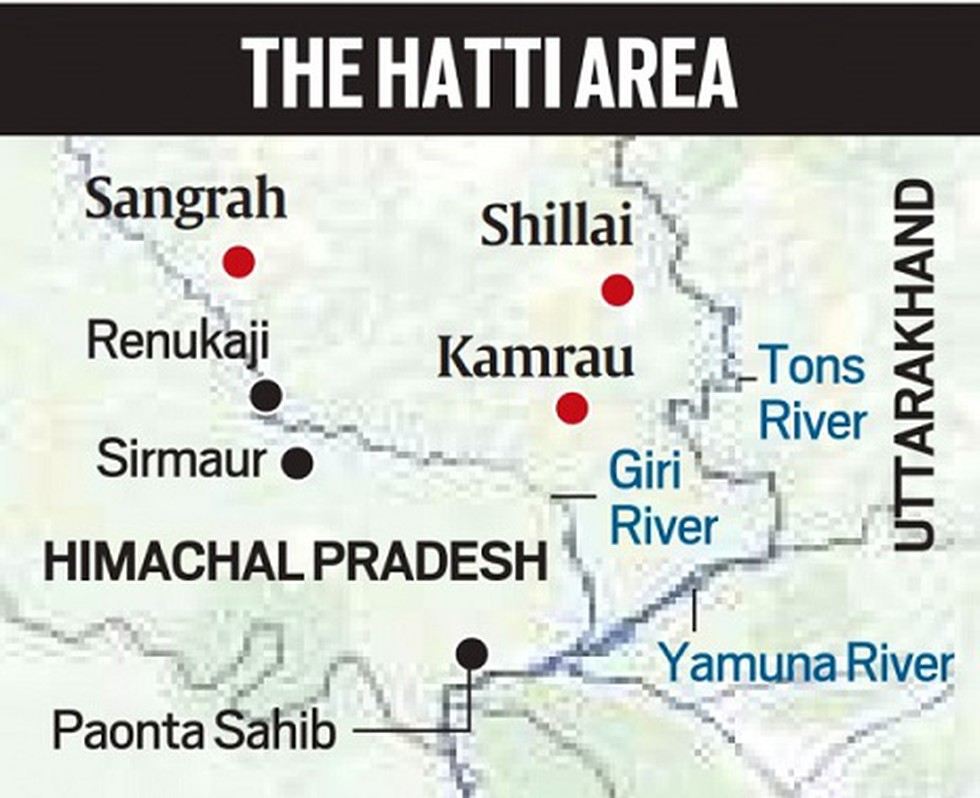Context
-
The Centre is reported to be considering granting “tribal” status to Hattis Tribe of the Trans-Giri region of Himachal Pradesh’s Sirmaur district.
-
The demand to declare Trans-Giri a tribal area is old — and is tied up with the demand for Scheduled Tribe (ST) status for the Hatti community which lives in the area.
About Hattis Community
- The Hattis are a close-knit community who take their name from their traditional occupation of selling home-grown crops, vegetables, meat, and wool at small-town markets known as ‘haats’.

- Hatti men traditionally don a distinctive white headgear on ceremonial occasions.
- The Hatti homeland straddles the Himachal-Uttarakhand border in the basin of the Giri and Tons rivers, both tributaries of the Yamuna. The Tons marks the border between the two states, and the Hattis living in the Trans-Giri area in today’s Himachal Pradesh and Jaunsar Bawar in Uttarakhand were once part of the royal estate of Sirmaur. Jaunsar Bawar was conquered by the British in 1814.
- The two Hatti clans, in Trans-Giri and Jaunsar Bawar, have similar traditions, and inter-marriages are common. However, a fairly rigid caste system operates in the community — the Bhat and Khash are upper castes, and the Badhois are below them, and inter-caste marriages have traditionally been discouraged.
- The Hattis are governed by a traditional council called ‘khumbli’ which, like the ‘khaps’ of Haryana, decide community matters.
Requirement of ‘tribal’ area
- In its reply in Parliament, the government laid down the requirements for such designation, and the reason why Himachal Pradesh’s claim could not be considered.
- It said that the Constitution provides for two types of areas: “Scheduled Areas” in terms of the Fifth Schedule of the Constitution, and “Tribal Areas” in terms of Sixth Schedule. “The “Tribal Areas” are designated in terms of Article 244(2) of the Constitution…read with Sixth Schedule… Himachal Pradesh submitted a proposal for notifying entire Trans-Giri area of Sirmour district, Dodra Kwar Sub-Division of Shimla district, 15/20 areas of Shimla and Kullu districts as Scheduled Areas in Himachal Pradesh.”
- However, the government said, “for declaration of Scheduled Areas the criteria followed are: preponderance of tribal population, compactness and reasonable size of the area, a viable administrative entity such as a district, block or taluk, and economic backwardness of the area as compared to neighbouring areas.
Demand for tribal status
- The list of STs in Himachal Pradesh includes Gaddis, Gujjars, Kinnaras (Kinnauras), Lahaulas, Pangwalas, and some other smaller tribes. The bulk of the tribal population lives in remote, high altitude areas in the districts of Lahaul, Spiti, Kinnaur, and Chamba.
- The Hattis have been demanding ST status since 1967, when tribal status was accorded to people living in Jaunsar Bawar in Uttarakhand, which shares a border with Sirmaur district. Over the years, various ‘maha khumblis’ passed resolutions pressing the demand.
- “[Hattis of Jaunsar Bawar] share similar culture and socio-economic conditions with the Hattis residing in Sirmaur.
- Since getting the benefit of reservations, the Jaunsar Bawar area has produced a sizable number of civil servants. Due to topographical disadvantages, however, the Hattis living in the Kamrau, Sangrah, and Shilliai areas of Himachal Pradesh have lagged behind in both education and employment.
- The Hattis have a sizable presence in about nine Assembly seats in the Sirmaur and Shimla regions. Their population is concentrated in the four Assembly constituencies in Sirmaur district — Shillai, Paonta Sahib, Sri Renukaji, and Pachhad (all part of the Shimla Lok Sabha seat).
Reference: IE
Visit Abhiyan PEDIA (One of the Most Followed / Recommended) for UPSC Revisions: Click Here
IAS Abhiyan is now on Telegram: Click on the Below link to Join our Channels to stay Updated
IAS Abhiyan Official: Click Here to Join
For UPSC Mains Value Edition (Facts, Quotes, Best Practices, Case Studies): Click Here to Join
